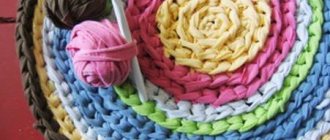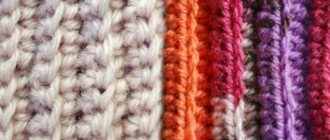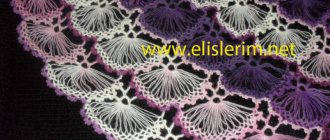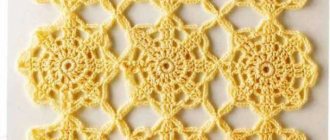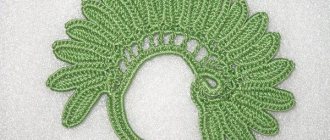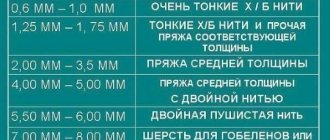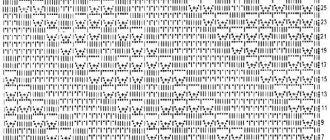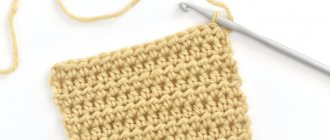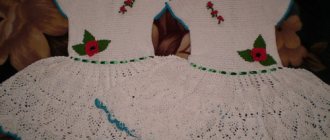Hello, friends!
Today we have a new topic: crochet - hexagonal motifs. I have prepared a large selection of patterns from simple to beautiful openwork motifs and ideas of what things can be knitted from them.
All photos are taken from open sources on the Internet; they were mainly published on foreign websites and magazines.
From hexagons you can knit a huge number of different items, including for comfort in the home. And depending on the product, these can be simple dense motifs or elegant openwork ones. Things made from colored motifs look especially beautiful and bright.
Choose a scheme to your liking.
Crochet hexagonal motifs - simple patterns
To crochet a hexagonal motif in the simplest way, make a slip loop and knit several double crochets (or single crochets) into it. Moreover, this number must be a multiple of six, i.e. 6 or 12.
- And then they knit in a circle, making increases in the rows in six equally distributed places.
- In the second row, you need to knit two stitches in each loop.
- In the third row - in every second column.
- In the fourth - in every third.
Those. in fact, approximately the same as when knitting a circle. But in order to form a hexagon, increases must always be made on the same column of the previous row, and when knitting a circle, an offset must be made each time.
To make it even easier and the pattern more interesting, use a diagram.
Sunflower motifs
A very popular pattern among needlewomen is the sunflower motif, it is also very simple, and you can knit in different colors and get other types of flowers, the same daisy, for example.
You can watch the video on how to knit a simple sunflower.
And also other suitable schemes:
Afghan hexagonal flower motif
Many people love the Afghan motif, and not only the hexagonal one, it is notable for the fact that its center is decorated with a beautiful flower.
The diagram is in front of you, as well as a video tutorial on how to knit such a motif.
Schemes of beautiful openwork hexagonal motifs
Such motifs are useful for knitting tablecloths, curtains and other things. Moreover, according to some patterns, you can even knit an independent product from just one motif - an oven mitt, a snowflake, a small napkin.
Crochet items made from hexagonal motifs
You can knit anything from hexagonal motifs:
- and dresses, and skirts, and tops
- stoles
- slippers, footwear, boots
- pillows
- napkins, tablecloths, coasters
- rugs
- blankets
- bags
- toys
- pincushions.
- Let's start with a few recommendations.
- Depending on the type of product, we buy the yarn we need: acrylic or acrylic with wool is suitable for blankets, cotton thread for pillows and bags, thicker yarn for rugs, and thin cotton threads for napkins and tablecloths.
- ♦ Which yarn to knit rugs from and which yarn is better: an overview of types of yarn for crochet rugs
- We use the thread thickness and hook number accordingly.
- Look at some photos to see what might happen.
Bags
- To crochet a bag from hexagonal motifs, you can take any pattern, but here I will give a diagram for assembling the motifs.
Slippers, boots
The photo shows boots made from hexagonal crochet motifs by Larisa Sankevich from our long-standing competition. A detailed description of the work can be found here>>.
Toys, pincushions
The Afghan motif is mainly used here, but you need to know the layout patterns in each individual case.
Tablecloths, napkins, coasters
Rugs
- ♦ Description of knitting rugs for the bathroom
Blankets
- It seems to me that crocheting a blanket with hexagonal motifs is such a field of activity; you can use all kinds of colors, patterns, and pick up leftover yarn.
- A relative novelty among them is a very beautiful blanket of seven types of motifs with different colors, which are called Frida’s flowers after their creator.
- I post patterns of multi-colored flowers in hexagons, and you can help figure out how to knit them (the first motif) using the video, although it is not in Russian.
- I think the rest of the lessons will not be difficult to find.
How to Crochet Hexagonal Motifs
- In blankets, rugs, bags and other products, as a rule, they combine ready-made motifs.
- To do this, the motifs are steamed with an iron, folded with each other face inward, aligning the edges, and connected with a hook, grabbing only the outer loops, using connecting posts.
In this case, the motifs are arranged among themselves in a checkerboard pattern, resulting in an uneven broken edge of the product. If desired, it is left in this form, tying the entire work around the perimeter with rows of single crochets.
To get a rectangular product with a smooth edge, you will have to knit more halves of the motifs, or fill the gaps between the motifs along the edges with columns with different numbers of crochets: first in ascending order, then in descending order. For example: 2СБН, 2С1Н, 3С2Н, 2С1Н, 2СБН.
- In openwork thin products, the connection is made in the process of knitting the last row of each motif: make an air loop, perform a single crochet, grabbing the ready-made motif, again air.
- I hope that these hexagonal crochet motifs with patterns will be useful for your creativity.
- Sincerely, author of the blog “The Comfort and Warmth of My Home” Olga Smirnova
- Interesting ideas and schemes:
Source: https://comfort-myhouse.ru/rukodelie/masteritsyi/shestiugolnye-motivy-kryuchkom.html/
Selection of schemes
Popular and simple patterns of hexagonal crochet motifs will definitely come in handy when creating new things and patterns. With their help, you can understand how to crochet a hexagon for beginners, as well as master the “Snowflake” pattern, which will gracefully fit into the most sophisticated wardrobe items.
Having mastered the basics of crocheting hexagonal motifs, you will be able to create things of any complexity, even if you have only recently held a crochet hook in your hands. It is enough to believe in yourself and not doubt your abilities!
How to crochet a colored hexagon
In this master class we will demonstrate the process of knitting a motif in which a circle fits into a hexagon. And we will make it from yarn of three colors. To knit this motif we took:
- red, coral and blue yarn;
- corresponding hook.
To create a round element, first use blue yarn, form a slip loop from it and knit 3 chain stitches on it. loops.
Next we will knit with double crochets. In total, 11 such columns need to be performed in a sliding loop.
We tighten the initial loop and close it into a ring with a connecting loop, knitting it in the third air. lifting loop.
Cut the blue thread and fasten it.
We will perform the next row with coral-colored yarn. First, we attach ourselves to the blue circle.
We knit 3 air. loops and then perform 3 broaches with crochets in the same base loop.
Next we knit all the broaches.
And after that we combine the remaining 2 loops on the hook. We got such a magnificent column.
Then we knit 2 air. loops, after which we knit a lush column consisting of four broaches with crochets into the next blue loop of the base.
Thus we continue knitting in a circle. In total, in this row we should have 12 lush columns. We finish knitting with this color with a connecting loop.
- We have created such a round two-color element for the future motif.
We will perform the next row with red yarn. To do this, we attach ourselves to the arch and perform 3 air. loops.
- Then we knit 2 double crochets here.
Tablecloth made of knitted hexagons. Crochet hexagon
HomeMiscellaneous Crochet hexagon
A simple but very beautiful hexagon for knitting blankets, blankets, pillows and other products using the patchwork technique. In such a knitting project, a lot depends on the chosen combination of colors, their alternation both within one motif and their location in the blanket itself. This post will provide a step-by-step analysis of hexagon knitting with examples of work from this hexagon.
This is what the finished crocheted hexagon should look like.
You will need: Hook No. 4 Medium thickness yarn in different colors
Size: side - 6 cm, 11 cm in diameter.
Description: ch 4 join into a ring by working a dc in the first ch. Row 1: ch 3, 11 dc in the ring, dc in the top ch. from 3 ch. for lifting. Finish with this color. You should get a circle of 12 columns.
Row 2: Attach a thread of a different color to any stitch. 2 ch, 1 dc in the same loop, 1 ch, * 2 dc with a common top in the next. loop, ch 1, repeat from * to end of row, sl st in ch 2. lifting - (total 12 pairs of columns and 12 arches from 1 vp). Finish with this color.
2 dc with a common top and a common stitching point: yarn over, insert the hook into the next. loop, grab the thread and pull a loop (3 loops on the hook), grab the thread and pull it through 2 loops (2 loops left on the hook). The first unfinished column is ready.
Yarn over and insert the hook into the same loop where you just knitted the first unfinished stitch. Grab and pull the thread (4 loops on the hook), grab the thread and pull it through 2 loops on the hook (3 stitches left.
on the hook), grab the thread and pull it through all 3 loops
Row 3: Attach a thread of a different color to any arch of 1 ch. Knit into it: 3 ch, 2 dc, 1 ch, * 3 dc in next. arch of 1 ch, 1 ch, repeat from * to end of row, sl st in top ch. rise - (a total of 12 groups of 3 dc, connected in arches of 1 ch between pairs of unfinished columns of the previous row). Finish with this color.
Row 4: (a series of arches from vp) attach a thread of a different color to any arch from 1 vp. between groups of 3 dc from the previous row.
(3 ch, sl st in the next arch of 1 ch) repeat until the end of the row, end with a sl st in the first arch of 3 ch. Continue working with this color.
Row 5: (the last row that gives the motif a hexagon shape). 3 ch, 2 dc in the same arch, 2 ch. (this will be a corner arch), 3 DC in the same arch. The result is the first corner of the hexagon. 3 dc in next.
arch of 3 vp, *(3 dc, 2 vp, 3 dc) in the next. arch of 3 vp, 3 dc in the next. arch of 3 v.p.
, repeat from * to the end of the row, end with a sl st in the top lifting loop - (you should get 6 corners and 6 groups of 3 dc between them).
To finish work.
yshikaplys.blogspot.com
Hexagonal crochet motifs are easy and quick to crochet, and are the basis for many interesting and colorful projects. For example, you can knit a beautiful tablecloth.
First you need to knit the required number of hexagons.
Knitting begins with an “amigurumi loop” (magic loop).
Next, we make 2 air lifting loops and knit a double crochet into a ring. Again 2 chain stitches and 2 double crochets. We repeat 2 loops + 2 double crochets until we get 6 sectors of 2 stitches in the ring, and 2 chain loops between them, tighten the amigurumi loop:
We close the row by pulling the loop into the second lifting loop at the beginning of the row:
Next row: make 3 chain stitches and double crochet in the next stitch. In the gap where there are 2 chain loops of the previous row, we perform a double crochet + 2 chain loops + a double crochet.
Next, 2 double crochets and again in the gap between two chain stitches we perform a double crochet + 2 chain crochets + double crochet. And so on until the end of the row. We close the row by pulling a loop into the top loop of three lifting loops.
The result was a workpiece of 6 groups: 4 double crochets and 2 chain loops between the groups.
We knit the next row in the same way as the previous one: we knit double crochets above the double crochets, and in the gap with the chain stitches we work a double crochet + 2 chain loops + a double crochet. We get a workpiece: 6 groups of 6 columns and between groups of 2 air loops.
We knit 2 more rows in the same way, we get groups of 8 and 10 columns. The hexagon is ready.
You need to knit as many of these hexagons as needed for the intended product. You can impose multi-colored motifs, you can alternate the color of the yarn in each motif - as your imagination dictates.
Next we will connect the hexagons into a canvas.
We arrange the motifs into the desired form:
We take 2 motifs, fold them inside out to each other and tie them with single crochets to the back wall of the loop.
Connect the hexagons as you wish: you can start with the central motif and tie its sides, and then attach further motifs. You can knit strips of motifs, and then connect the strips to each other.
- After the assembly is completed, the product must be tied around the edge.
- We begin to tie the edge with single crochets at the back wall of the edge loop; it is more convenient to start from the middle of one of the motifs (not from the corner). Having reached the top of the corner (where there are 2 chain loops), perform a single crochet in the first loop, then a chain loop and a single crochet in the second loop:
- Having reached the recess, we perform 2 single crochets with a common top, grab the loop of the first motif, pull it out, grab the loop of the second motif, pull it out and knit all the loops on the hook:
- We perform the next row of tying with double crochets. At the tops of the corners, where the chain loop is, we knit a double crochet + chain crochet + double crochet:
- In the recesses we make 3 double crochets with a common top: we grab the post in front of the corner, the corner post (which in the previous row is double with a common top) and the post after the recess:
We complete the tying with single crochets. At the tops of the corners in the space with an air loop we perform 2 single crochets, in the recesses we knit three columns with a common vertex: a column in front of the corner, in the corner and the next column we knit together.
Ways to get a figure
Knitting hexagons is usually based on circles. That is, knitting begins with a set of air loops. The number of columns on the chain must be a multiple of 6 for correct division into sectors. Let's look at an example for beginners of how to crochet a hexagon with double crochets:
- Fold the amigurumi ring, make 3 air loops (VP) lifting.
- Knit the first row of double crochet stitches (DC) into a ring according to the pattern *2DC+2VP* (repeat 6 times between **). In the first rapport, count a chain of 3 VPs as 1СН. Close the row with a connecting column (CC).
- In the second row *2DC+2DC+2VP* repeat 6 times + SS.
- Next, make increments over each extreme DC in the rapport. That is, the third row will look like *2Dc+Dc+Dc+2Dc+2VP* + SS.
Following this description, you can get the simplest hexagon. However, you can knit the hexagon differently; in this case, the knitting will not go from the center, but in a straight line. Increases are placed at the beginning of each row, as well as at the end, and when the required size is reached, symmetrical decreases are made.
Master class on knitted hexagons
Master class from Svetlana Bezovchuk. Svetlana will tell you how to connect hexagonal motifs together. In this way, you can knit anything from leftover yarn: a blanket, shawl, handbag, skirt, top, dress, scarf, etc.
| First we knit the very first and main hexagon. We knit 5 air loops and close them into a ring. Then we knit 9 double crochets into the ring. |
| We change the thread and now knit 2 double crochets into each loop, you should get 12 borders. |
| We change the thread again and in each resulting hole we knit 3 double crochets and again we should get 12 borders. |
| We change the thread and knit 4 air loops, knit them into the hole in the border and do this until the end. It turns out like this chamomile. |
| Now the most important thing is to make the edges of our hexagon. In the first hole we knit: 4 double crochets, 1 chain crochet and again 4 double crochets + chain stitch. Then into the next hole of our daisy we knit 4 double crochets + chain stitch. In the third hole of the daisy we knit 4 double crochets + an air loop and again 4 double crochets. This is one side of the hexagon. Next, we also continue to knit, making six sides of our hexagon. |
| WE HAVE KNITTED THE MOST BASIC HEXAGON AND IT SERVES AS THE BEGINNING OF THE WHOLE PRODUCT. Now knit exactly the same daisy, but we are not making sides for it, but we will knit it to the main hexagon. In the first hole we knit 1 chain loop + 4 double crochets + chain loop and draw the hook into the corner (the middle between 8 double crochets) of the second hexagon. We drag the thread and knit. |
| Now we knit 4 double crochets + 1 chain stitch into the same hole. |
| We draw the hook into the second hexagon again and knit the thread. |
| Now into the next hole we knit 4 double crochets + 1 chain stitch. We pass the hook into the second hexagon and knit a loop. |
| Now we place the hook in the middle of the joints of the two hexagons and knit a loop. |
| And again we knit 4 stitches + 1 air loop into the same hole. |
| Thus we knit further. |
| Now we continue to simply knit the sides of the hexagon. |
| This is how we connect all the hexagons. |
Svetlana lives in Nizhny Novgorod and knits wonderful toys to order. You can view and purchase her works on the website https://svetlana-bezovchuk.jimdo.com/.
Source: https://kru4ok.ru/master-klass-po-vyazanym-shestiugolnikam/
Crochet hexagon -5 patterns available
Hexagonal crochet motifs are one of the basics that should be mastered by all those who can no longer imagine their life without a hook and a skein of thread.
These are basic elements that can be used in the future in a lot of interesting projects, from creating interior items (the most logical options are rugs, blankets, sofa pillows) to clothing and accessories.
In general, with the help of crocheted hexagons you can do anything if you have the desire to create and create, a little imagination and tireless hands. As a result, you will receive not only an interesting unique thing and invaluable experience, but also a charge of positivity and a lot of positive emotions. A crochet hexagon is a great idea for today's project!
Modeling from hexagons
Probably everyone has heard about the patchwork technique, which is patchwork sewing. But you don’t have to sew only from pieces of fabric. Everyone's favorite crocheted hexagonal motifs will also be useful for work. By making many of these samples and combining them into one, you can create something incredibly original and sophisticated.
Unusual toys and bags
Knitted toys are quite original gifts that fill not only their owner with positivity, but the craftsman who created them for kids. Once in your life you try to make something with your own hands, you can’t stop - you want to create and give the world these funny creatures. Fortunately, knitted toys are now gaining more and more popularity. For example, hexagons make cute balls, bear cubs, hippos, scops owl toys (children hug them when they sleep), comforters and much more.
Knitted bags, which are an integral part of a woman’s summer wardrobe, look no less impressive. In the everyday arsenal of today's fashionistas, it is imperative to have at least several of these attributes. They will fit perfectly into almost any outfit , be it a classic suit or regular jeans and a T-shirt.
They also differ in their appearance: some resemble antique reticules, others resemble beach bags, and others resemble backpacks. Considering the color and shape, every fashionista will be able to choose exactly what suits her.
Decor elements
Using just one type of crochet hexagonal pattern, you can try to create an incredible array of beautiful and useful products for your home. You just need to skillfully use combinations of various shades and textures of yarn to get an original decorative element in subdued tones or flashy colors. Knitted accessories include:
- coasters, potholders, teapot warmers;
- napkins, tablecloths, decorative runners;
- pillowcases;
- rugs, blankets;
- rugs;
- covers for armchairs and sofas;
- warm seats for chairs;
- ottomans, etc.
There is no limit to creativity, you just have to decide what exactly you are going to make.
Original clothes and shoes
Using hexagons, you can create various tops, dresses, skirts, cardigans, shorts and much more. You just need to arm yourself with yarn and a crochet hook, and then at any time of the year you will look bright and irresistible in your unique outfits, whether in the office or on the beach.
Crochet hexagon slippers pattern for beginners
We'll have to start with a small retreat! I always, no matter whether it was cold or hot at home, winter or summer, wore socks at home. In the cold season for warming the feet, and in the warm season for caring for the feet (let’s leave this without details, this is not about that now).
My close relative convinced me that it is more comfortable to walk in slippers. Although I didn’t believe her, I decided to check it out, and, indeed, it turned out to be much better. But another problem arose: in stores, despite a huge assortment of goods, there were few attractive models for me.
I'm quite a picky shopper! Having looked around a bunch of counters, I couldn’t find the model that suited me in terms of quality, color, style and price. But I still bought a pair of slippers; in everyday conditions they quickly got dirty, as indicated in the instructions; I poured warm water into a basin and washed them by hand without any effort.
I cleaned the stains with a brush!
After the first wash, the bows that the manufacturers put on with glue fell off! After the second wash, the slippers fell apart and the foam began to fall out. So what are these things now? Everything is glued! Nothing is stitched!
I didn’t see the point in spending more money on such “super quality” and decided, after scouring the Internet, to knit myself slippers!
Girls, I found this option: easy to make, quick to knit, not expensive, and most importantly high quality and beautiful!
This model fits perfectly on the foot. By crocheting such slippers from delicate yarn in pleasant shades, you can wear them not only at home, but also flaunt them on the street. If close friends or relatives are planning a holiday, knit these slippers as a gift, and they will be delighted!
A simple pattern for crocheting slippers from hexagon motifs will delight both experienced craftswomen and novice needlewomen. Moreover, from simple hexagonal motifs you can knit not only slippers, but also boots. How? Yes, very simple! Let's talk about everything in more detail and in order.
Detailed description of knitting slippers
The slippers consist of hexagonal motifs that are knitted very simply and easily. The size of the crocheted slippers I described is equal to foot sizes 36-38.
We will need:
- yarn 100 microfiber “Magic” 225 meters in 100 grams.
- hook No. 3
- scissors
- tape measure
First row: cast on a chain of 6 chain stitches and close them into a ring. We make three lifting chain stitches and knit seventeen more double crochets in this row. There are eighteen double crochets in total.
Second row: we make two lifting air loops, insert the hook into the first loop from the previous row, pull it out, again insert the hook into the same loop, base and pull the thread one level. There should be five loops on the hook, we knit them together, so we have a fluffy column. We knit one air loop. We continue like this until the end of the row.
Third row: we knit two chain lifting loops, then yarn over the hook and insert it into the first arch (chain loop of the previous row, between the lush columns).
We pull out the hook, knit the first two loops and two more remain on the hook, make a yarn over and insert it again into the same arch, pull out the thread and knit two loops together, you should get three double crochets with a common top. This is how we knit the entire row.
Fourth row: Now you need to make a hexagon out of the circle! Three air loops of lifting go into five double crochets in the first loop of the base, in the next arch, knit three double crochets, then again three double crochets. We repeat this until the end of the row.
Fifth row: We knit single crochets in a circle, one stitch in each base loop. If you want your hexagon to look sharper, there were five double crochets in the previous row. In the third column you need to knit two single crochets.
This is how the motif is simply knitted - a hexagon for our slippers. We will need six such motifs for two slippers.
When the hexagonal motifs are ready, sew them together and sew them to the felt insole. Your slippers are ready.
